Ever wondered how your favorite decaf coffee gets it’s kick taken out? Coffee beans naturally come packed with caffeine. It’s what gives us that energy boost we love.
But some guys want to enjoy the taste of coffee without the jitters. That’s where decaf comes in handy!
Now, you might think they use harsh chemicals to strip away the caffeine. But guess what? There are actually some pretty cool ways to do it by using a completely natural process. Let’s explore how they pull off this coffee transformation.
The Water Process: Nature’s Way
One of the most popular methods is called the water process. It’s super simple and uses – you guessed it – just water!
Here’s how it works:
- First, they take green coffee beans (that’s before they’re roasted) and soak them in hot water.
- The water absorbs the caffeine, along with some of the flavors and oils from the beans.
- They separate the beans from this caffeine-rich water.
- Next, they filter the water to remove just the caffeine, leaving behind the good stuff.
- The beans then get soaked again in this flavor-rich, caffeine-free water.
- The beans soak up the flavors they lost earlier, but without the caffeine!
The Swiss Water Process: Taking It Up a Notch
The Swiss Water Process is a fancier version of the water method. It’s so precise, it can remove 99.9% of the caffeine!
Here’s how it works:
- They start by making a super concentrated coffee extract from a batch of beans.
- This extract is then filtered to remove all the caffeine, creating what they call Green Coffee Extract (GCE).
- New beans are soaked in this GCE.
- Because the GCE is already packed with coffee flavors, only the caffeine moves from the beans into the liquid.
- They keep cycling fresh GCE through until almost all the caffeine is gone.
The CO2 Method: Bubble Power
This method sounds like something out of a sci-fi movie, but it’s real and it works great. Here’s how they do it:
- Coffee beans are placed in a big steel container.
- They pump in carbon dioxide (CO2) at very high pressure.
- Under these conditions, CO2 becomes “supercritical” – it’s like a liquid and a gas at the same time!
- This supercritical CO2 acts like a magnet for caffeine molecules.
- As it flows through the beans, it pulls out the caffeine.
- The caffeine-loaded CO2 is then separated, and the caffeine is removed.
- The CO2 gets recycled to use again and again.
Why Go Chemical-Free?
You might be wondering, “Why bother with these fancy methods?” Well, there are a few good reasons:
- Better Taste: Chemical processes can sometimes leave a funky aftertaste.
- These natural methods keep more of the coffee’s original flavors.
- Health Conscious: Some people prefer to avoid any extra chemicals in their food and drinks.
- Environmental Friendly: These methods often use less energy and produce less waste.
- All-Natural Appeal: Many coffee lovers appreciate knowing their decaf is processed naturally.
The Decaf Dilemma: Is It Really Caffeine-Free?
Here’s a fun fact: Even after all this work, decaf coffee isn’t 100% caffeine-free! But don’t worry, it’s pretty close.
Most decaf coffees still have about 2-3% of their original caffeine content. For comparison, that’s like taking a regular cup of coffee and pouring out all but a tiny sip.
So if you’re super sensitive to caffeine or need to avoid it completely for medical reasons, you might want to check with your doctor before gulping down decaf by the gallon.
The Roasting Process
Once the caffeine is out, the beans still need to be roasted. This is where the magic of flavor happens. Roasting decaf beans can be tricky because they react differently to heat than regular beans.
It takes a skilled roaster to bring out the best flavors in decaf coffee.
Light roasts tend to keep more of the bean’s original flavors, while dark roasts can help mask any slight differences from the decaffeination process. It’s like giving the beans a new outfit to show off their best features!
Decaf Myths Busted
Let’s clear up some common misunderstandings about decaf coffee:
- “Decaf tastes bad”: Not true!
- With modern methods, decaf can taste just as good as regular coffee.
- “It’s not worth drinking”: Decaf still has lots of health benefits, like antioxidants.
- “It’s totally caffeine-free”: As we learned, there’s usually a tiny bit left.
- “It’s processed with harmful chemicals”: Not if you choose coffees made with the methods we talked about!
The Future of Decaf
Scientists are always looking for new ways to make decaf even better. Some are even working on breeding coffee plants that naturally have less caffeine.
Here’s what happens when decaf is just as easy to grow as regular coffee.
As more people become interested in controlling their caffeine intake, the demand for high-quality decaf is growing. This means coffee companies are putting more effort into making decaf that’s just as tasty as the regular stuff.
Choosing Your Decaf
When you’re picking out decaf coffee, look for brands that tell you how they remove the caffeine. If they use one of the methods we talked about, you know you’re getting a natural product.
Also, pay attention to the roast level.
Try different ones to see what you like best!
PureCoffeeCraft is a participant in the Amazon Services LLC Associate Program, an affiliate advertising program designed to provide a means for sites to earn advertising fees by advertising and linking to Amazon. There is no extra cost to consumers for clicking on the following links.
Decaf Coffee Reviews: Top 5 Amazon Picks
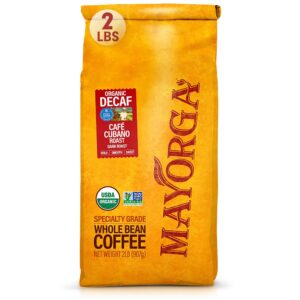
Now that we know all about how decaf is made, let’s check out some popular options you can buy online. Here are reviews of five decaffeinated coffees available on Amazon:
1. Mayorga Organics Decaf Café Cubano
This dark roast coffee brings a bold, smooth flavor with hints of vanilla and sweet, syrupy smokiness. Mayorga uses the Swiss Water Process, so you know it’s chemical-free.
Fans love it’s rich taste that doesn’t compromise on flavor despite being decaf.
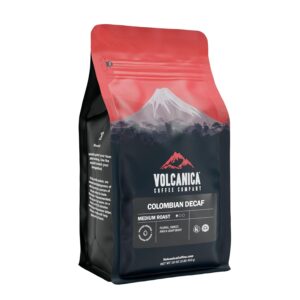
2. Volcanica Coffee Company Decaf Colombian Supremo
Volcanica’s offering is a medium roast with a well-balanced body and a sweet, fruity aroma. They also use the Swiss Water Process for decaffeination.
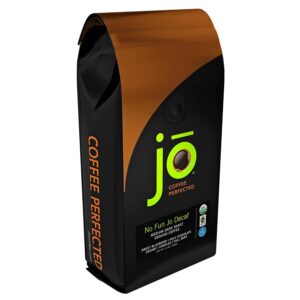
Customers rave about it’s smooth taste and how it’s nearly indistinguishable from regular coffee.
3. Jo Coffee No Fun Jo Decaf
This medium dark roast boasts a full body with notes of blueberry and chocolate. Jo Coffee uses the Swiss Water Process too.
Reviewers appreciate it’s robust flavor and the fact that it’s organic and Fair Trade certified.
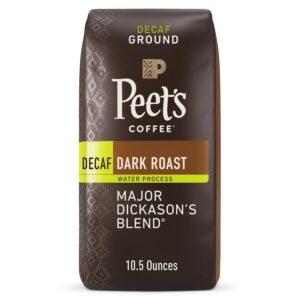
4. Peet’s Coffee Decaf Major Dickason’s Blend
Peet’s delivers a dark roast with a complex, full-bodied flavor. They use a water process for decaffeination.
Coffee lovers praise it’s rich taste and how it stands up well to milk and cream.
5. San Francisco Bay Coffee Decaf Gourmet Blend
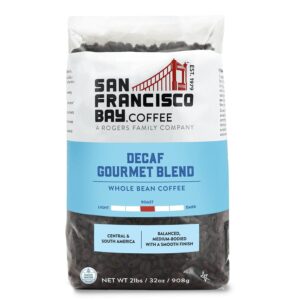
This medium roast offers a smooth, well-rounded flavor with a gentle sweetness. San Francisco Bay uses a natural water process.
Customers love it’s mild taste and the eco-friendly packaging.
| Brand | Roast | Decaf Method | Notable Flavors |
|---|---|---|---|
| Mayorga Organics | Dark | Swiss Water Process | Vanilla, smoky sweetness |
| Volcanica Coffee | Medium | Swiss Water Process | Sweet, fruity |
| Jo Coffee | Medium Dark | Swiss Water Process | Blueberry, chocolate |
| Peet’s Coffee | Dark | Water Process | Complex, full-bodied |
| San Francisco Bay | Medium | Water Process | Smooth, gentle sweetness |
Each of these decaf options brings something unique to the table. Whether you prefer a bold dark roast or a smooth medium blend, there’s a decaf coffee out there for every taste preference.
The best part?
They’re all made using natural decaffeination methods, so you can enjoy your cup knowing it’s free from harsh chemicals.
New brands and blends are popping up all the time, so don’t be afraid to experiment and find your perfect cup!
Brewing Up the Perfect Decaf
Now that you’ve picked your decaf, how do you make sure it tastes it’s best? Here are some quick tips:
- Use fresh, cold water for brewing.
- Keep your coffee maker clean.
- Use the right grind size for your brewing method.
- Don’t let brewed decaf sit on a hot plate too long – it can get bitter.
- Experiment with different brewing methods like pour-over or French press.
Remember, just because it’s decaf doesn’t mean you should skimp on the brewing process. Treat it with the same care as regular coffee, and you’ll be rewarded with a delicious cup!
So there you have it – the ins and outs of how they make decaf coffee without chemicals. It’s pretty cool how science and nature team up to give us the best of both worlds: great coffee taste without the caffeine jitters.